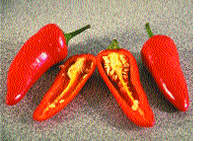|
|
 |


January/February
2001
 Some
Like It Hot Some
Like It Hot
While some
foods are bland and compliant, hot sauce is downright confrontational.
It will not be kicked around or intimidated by anything. If it’s
in there—even a little bit—you know it!
Chilies of the genus Capsicum are distant
cousins of the vanilla bean. They produce an oil called capsaicin that,
when eaten, brings a fiery sensation to the mouth. This stuff creeps slowly
and takes the tender mouth lining by surprise.
Drinking water does nothing to put out these fires.
Capsaicin is soluble only in oils and alcohol, so water just spreads the
oils around more evenly. Whole milk helps and bread is even better because
it sops up the oils.
South and Central American cultures were using
hot peppers at least 9,000 years ago and the ancient Mayans used cayenne
to treat gum inflammation. About 5000 B.C., native North Americans began
cultivating cayenne peppers and, about 6,500 years later, both cultures
began trading cayennes and habaneros to the European explorers, who returned
to the Old World with cries of, “Wait’ll you try this stuff!”
Shortly thereafter, pepper trade with the Orient spread the joy in all
directions.
In 16th-century Europe, capsicum was used not
only as food but also in medicines to promote digestion and stimulate
circulation. Capsaicin is still used in medicinal products to treat pain.
It has other uses, as well. In 1991, it was reclassified
by the U.S. Environmental Protection Agency as a biochemical pesticide
and registered by the U.S. Department of Agriculture as a repellent against
insects, dogs, birds, voles, deer, rabbits, and tree squirrels.
Any product containing capsaicin must be used with caution. Capsaicin,
used around the world in pepper sprays, can be extremely irritating to
mucous membranes and the eyes.
More than two million acres are devoted to the
production of cayenne pepper. Experts believe it to be the most widely
consumed spice in the world, with more than 25 percent of the world’s
population eating these peppers every day.
So why would anyone want to eat something like
this? Apparently, there is an addictive joy to eating them. Peppers produce
a mild euphoria within minutes after they are ingested because the body
secretes its own natural pain relievers, endorphins. The chemical makeup
of endorphins is like that of the opiates. Also like other addictive substances,
repeated use of capsaicin produces reduced response. Ergo, the more often
you eat them, the more it takes to get the effect.
In 1865, Edmund McIlhenny sparked the hot sauce
industry on Avery Island, Louisiana, with Tabasco. Most restaurants still
carry this pepper sauce—minus the cologne bottles—somewhere
behind the counter.
Most of the hot sauce mystique circulates around
the pleasure of the heat, but the different flavors of the sauces themselves
elude many people. Those of us who have survived a lifetime of self-inflicted
pain learn to appreciate those more subtle nuances.
Keeping in mind the increased-tolerance factor,
start small. If you want more heat after some practice, go for it. You
must become accustomed to the heat before you can enjoy the flavor, and
a lot depends on what you want to spice up. Sauces have bases of tomato,
papaya, onion, mustard, even oysters, but some have such a distinctive
flavor that the food they are supposed to enhance ends up tasting just
like the sauce.
Cayenne, habanero, jalapeño, and Scotch
Bonnet pepper sauces have distinct flavors. Any preparation that contains
the word “habanero” or “Scotch Bonnet” should be approached
warily and poked with a stick—unless, of course, the dinner guests
were uninvited.
If your idea of “plenty of seasoning”
is Worcestershire or A-1 sauce, you might not understand the appeal of
an eye-watering bowl of chili, but a lot of people begin to salivate as
soon as they read the words “hot sauce.” To those with more
masochistic taste buds, there is no doubt about it; hot sauce is cool.
Ken Richards, a freelance writer based in Ft. Myers, is a self-confessed
Chilihead.
|

